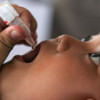Outbreak now more frequent
Outbreaks of food- and water-borne diseases in the country are on the rise. Last year, there were 15 outbreaks of diseases related to food and water compared to 11 the previous year, according to a government study.
An increasing number of people are suffering and sometimes even dying from diseases like cholera, diarrhoea, anthrax and nipah encephalitis.
Rodent excrement, close proximity of domestic animals to people and lack of safe water are the main reasons behind the increase, said Mahmudur Rahman, director of the Institute of Epidemiology, Disease Control and Research (IEDCR).
He was presenting a trend of their ongoing surveillance report on food- and water-borne illnesses at the IEDCR auditorium in the capital yesterday.
Outbreaks of nipah were reported in Manikganj-Faridpur, anthrax in Sirajganj, Tangail and Meherpur, food poisoning after watermelon consumption in Kushtia and Manikganj, diarrhoea in Chuadanga, Kushtia and Natore, and suspected food poisoning from cake intake in Chittagong in 2014.
Last year, there were nipah outbreaks in Naogaon, unintentional pesticide poisoning in Mymensingh, suspected cholera in Meherpur, suspected pesticide poisoning linked with litchi consumption in Dinajpur, anthrax in Meherpur, Kushtia and Gazipur, diarrhoea among pilgrims at Ashkona Haji camp in Tongi, diarrhoea in Narayanganj EPZ area, Jessore and Gaibandha, H5 in Mymensingh and Dhaka and food poisoning in Kishoreganj.
“Drinking boiled water at all times, avoiding unhygienic food, keeping clean and limiting the use of pesticides are ways to avert outbreaks of the diseases,” said Mahmudur Rahman.
The surveillance also found the presence of leptospirosis, a disease with symptoms like fever and jaundice that spread from rodent and domestic animal excrement in different districts. The highest 25 cases of the disease was reported from Uttara Adhunik Medical College hospital.
“Since its outbreak, whenever we get blood samples of fever, we check to see whether it is a case of leptospirosis,” Mahmudur told The Daily Star.
The regulatory authorities, including the Food Safety Authority, the departments concerning food production and processing or supplying water need to work vigorously to ensure food and water quality, he added.
Due to the rise in population, people are living in more congested houses than in the past and often their proximity to domestic animals are closer than before, he added.
Mahmudur also pointed out the outbreak of some of the food-and water-borne diseases were caused by the presence of rodent excrement in the food items.
For example, 46 cases of leptospirosis, were found in Dhaka and Narsingdi districts between May 2014 and December 2015.
The disease was also seen in Habiganj, Cox's Bazar, Naogaon, Patuakhali, Chittagong, Thakurgaon and Satkhira, according to the report.
In about 70 percent of the cases, the human infected with the disease dies, said Mahmudur, adding that the animal bearing the germ remain unaffected.
The surveillance focusing on water- and food-borne diseases collected stool and blood samples between May 2014 and December 2015 from district hospitals in Thakurgaon, Naogaon, Satkhira, Patuakhali, Habiganj, Narsingdi, Cox's Bazar, and Dhaka Medical College Hospital, Uttara Adhunic Medical College Hospital and Bangladesh Institute of Tropical and Infectious Disease (BITID) in Chittagong.
It collected a total 4,064 stool samples and 1,016 blood samples from jaundice patients and 2,113 blood samples from people with fever.
The surveillance also included interviews of randomly selected people over telephone asking them health-related questions and also their food and drink habits.
Mahmudur noted that awareness of people regarding food consumption that is potentially risky for their health also appeared to be low.
Despite reports of the nipah outbreak, the telephone survey carried out by the IEDCR showed that in June 2014, 951 out of 3,197 people drank raw date palm sap and in 2015, 820 out of 3,518 did so.
Experts have asked people repeatedly to refrain from drinking raw juice because it often contains excrement of bats containing the germ.
The surveillance showed that a number of districts in the country had outbreaks of anthrax in 2014-2015.
The germ of this disease enters the human body from domestic animals through cuts on the skin. It has been more common in the central and southwestern Asia.

 For all latest news, follow The Daily Star's Google News channel.
For all latest news, follow The Daily Star's Google News channel. 








Comments